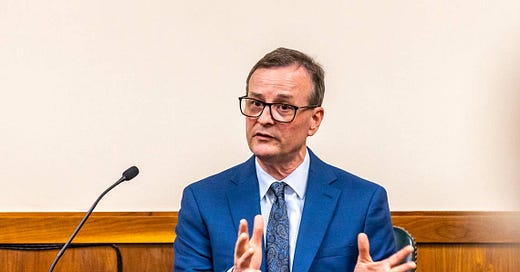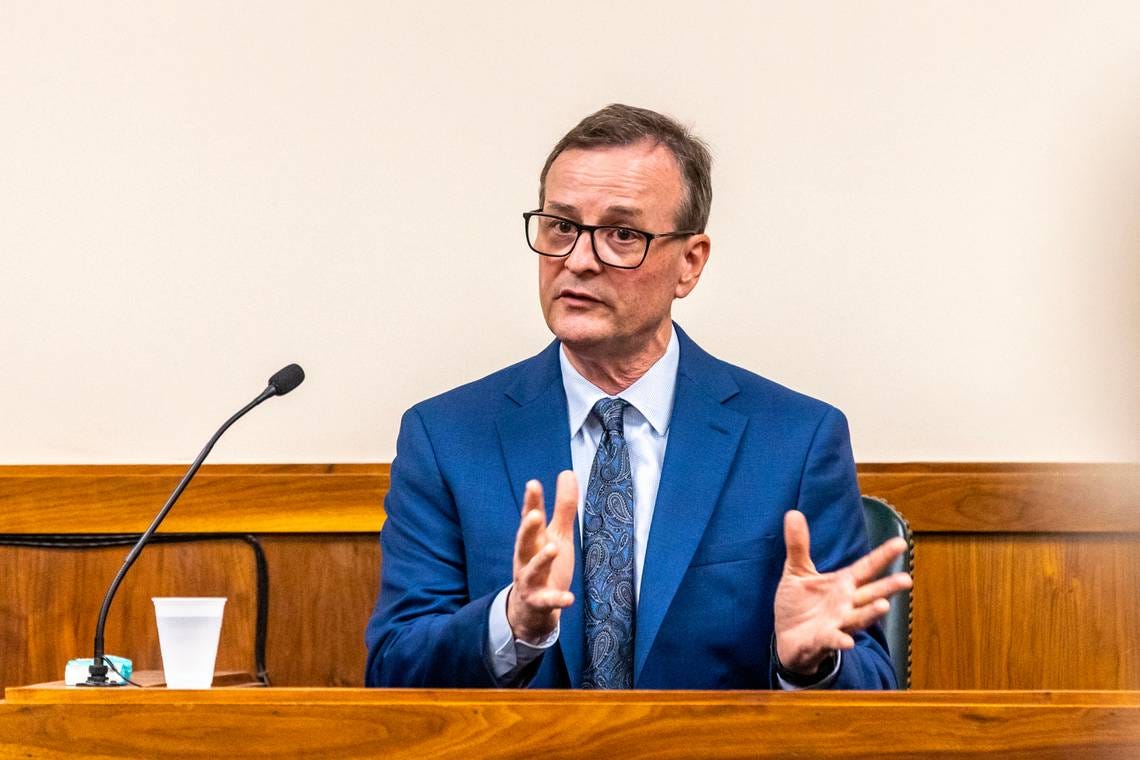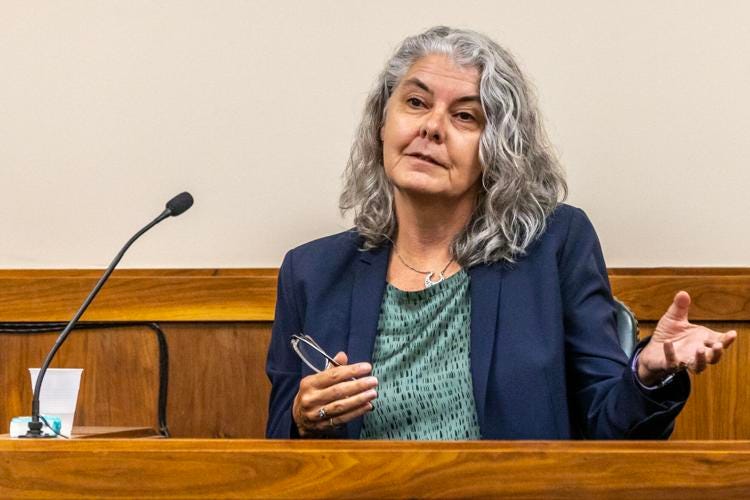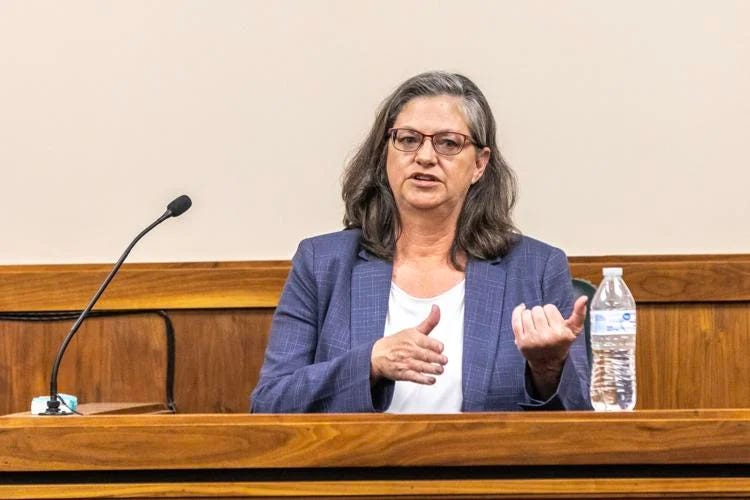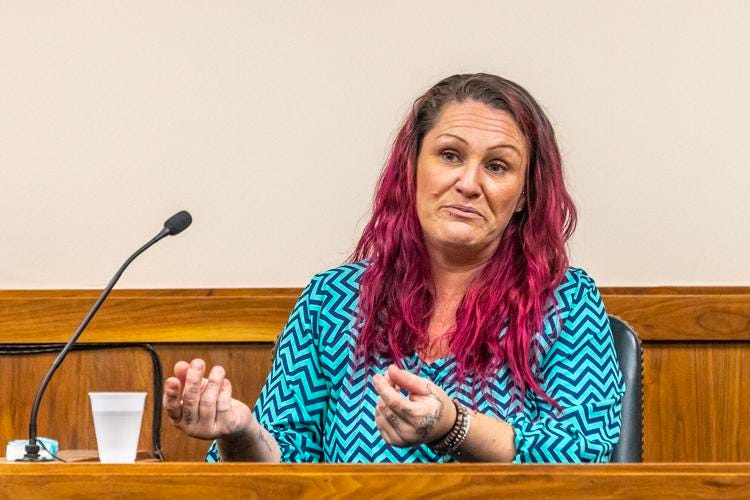Extended Hearing Summary: August 18, 2023
Wherein four expert witnesses testified about the investigative genetic genealogy process.
This post was originally published on September 25. Given the court’s recent order regarding the IGG materials, I am making this post available to free subscribers.
I have finally finished this summary after a month, which is just as well because the court hasn’t issued a ruling yet.
In their third motion to compel, the defense requested that documentation pertaining to the investigative genetic genealogy (IGG) process be turned over to the defense through the discovery process. The state replied that the defendant’s constitutional right to discovery does not extend to IGG information and that any rules cited by the defense do not apply. On August 18, the court heard from four expert witnesses retained by the defense to fully understand the issues at play regarding the IGG discovery.
Stephen Mercer
Stephen Mercer is a practicing criminal defense attorney in Maryland and the Washington D.C. area who specializes in forensic science litigation, specifically DNA. According to Mercer’s declaration filed in June, the defense retained Mercer to explain what a criminal defense attorney would need to do to sufficiently understand, investigate, and potentially challenge DNA evidence and the IGG process.
Mercer got his start challenging DNA evidence with the case State of Maryland v. Raines (2004). While serving time for two robberies, authorities collected Charles Raines’s DNA through a buccal swab and were subsequently able to match his DNA to that in evidence of a rape committed in 1996. This DNA match was used as probable cause to obtain a second DNA sample from Raines; the two samples combined led to a statistical probability that the DNA of the rapist belonging to anyone other than Charles Raines was one in six billion. Raines argued through his attorneys, one of whom was Mercer, that the collection of DNA from a certain class of persons is a violation of the Fourth Amendment protection from unreasonable search and seizure. The Maryland Court of Appeals ruled in favor of the state on the grounds that the search and seizure of Raines’s DNA through the buccal swab was reasonable.
Mercer later represented Alonzo Jay King Jr., the appellant in King v. State (2011) and the respondent in the United States Supreme Court case Maryland v. King (2013). King was arrested for first- and second-degree assault when his DNA was collected through a buccal swab and ran through a database of unsolved cases. The query resulted in a match for an unsolved 2003 rape case. The issue before the court was whether a buccal swab taken of the arrestee’s DNA was a violation of his Fourth Amendment right to protection from unreasonable search and seizure. (While the buccal swab for Charles Raines was collected after his conviction, King was merely an arrestee, not a convict.) In a piece about the case and Mercer’s role representing King, the Washingtonian describes Mercer’s view as follows:
From his point of view—one shared by civil libertarians—the Fourth Amendment draws a sharp line at the government’s physical intrusions into someone’s body to collect evidence of a crime without a warrant or probable cause. Mercer believes the government broke this rule with Alonzo King because they took his DNA when he was arrested—but not yet convicted—for one crime and used it to investigate him for another that they had no reason to suspect he had committed.
The Maryland Court of Appeals ruled in favor of King on the grounds that authorities had no probable cause to collect King’s DNA and compare it to DNA from other crimes. The state of Maryland then brought the issue to the United States Supreme Court, where appellate attorney Kannon Shanmugam argued for King. The court ruled in favor of the state in a 5-4 decision. Justice Kennedy stated in the majority opinion:
When officers make an arrest supported by probable cause to hold for a serious offense and bring the suspect to the station to be detained in custody, taking and analyzing a cheek swab of the arrestee’s DNA is, like fingerprinting and photographing, a legitimate police booking procedure that is reasonable under the Fourth Amendment.
In a 2014 paper for the NYU Annual Survey of American Law, Mercer and his co-author discuss law enforcement agencies’ use of state and local DNA databases, the existing regulations, gaps in statutory and judicial regulations, and potential proposals to close those gaps.
At the time of the paper’s publishing, investigative genetic genealogy had yet to be used
Future testing may include the rapidly expanding field of behavioral genetics in its search to establish causal relationships between genes and a host of adult behaviors related to criminality, such as mental illness, substance abuse, aggression, and impulsiveness.
Mercer’s Testimony
Mercer was asked to testify to answer the question, “What would a reasonable defense attorney do when confronted with DNA evidence that needs to be litigated?”
Mercer testified that for a reasonable attorney to represent their client effectively, the attorney must investigate the testing of any evidence central to the case. This includes DNA evidence. This is important in part to raise pretrial concerns like suppression issues and fourth amendment violations. While a fingerprint can identify a person without saying anything about them, a single nucleotide polymorphism (SNP) profile contains a vast amount of information. An attorney must understand this in order to properly evaluate privacy issues.
Mercer also argues that an attorney must investigate the reliability of the DNA’s short tandem repeat (STR) profile. In this case, there were multiple tests conducted on the same environmental sample of trace DNA, one of which produced an STR profile represented as a single-source male profile. Mercer says that the reliability of that testing needs to be investigated, which would include investigating the lab and documentation that was provided for the STR testing.
However, the attorney cannot investigate these issues without obtaining the discovery.
Bicka Barlow
Bicka Barlow is an attorney that consults on DNA cases. She was retained by the defense to explain the scope of discovery necessary to properly defense the case.
The defense questioned Barlow on the significance of the three unidentified male DNA profiles found at the crime scene. Barlow stated that if the three profiles go untested, then it is unknown whether those profiles exist in the CODIS database.
Barlow testified that each state has their own DNA database in addition to the federal CODIS database. The DNA profiles that are uploaded into CODIS depends on state-level rules and regulations, so not all DNA profiles in the state databases are uploaded into CODIS.
The defense asked Barlow why they would want to know if the other three unidentified male DNA profiles were put into CODIS. The state objected on the grounds that the three unidentified male DNA profiles were ineligible to be uploaded into CODIS. The court sustained the objection.
The defense then asked Barlow about a lab’s corrective actions and irregular results. Barlow testified that corrective action logs are part of a lab’s quality system; they are a way to track contamination, sample switching, and the presence of unknown contaminants. Labs must keep such documentation as part of the accreditation process and can help establish if the lab is using the proper protocols.
Barlow stated that investigative genetic genealogy has so far gone untested in the court system through cross-examination. Issues in the DNA process are discovered by the defense through the discovery process, when they can conduct their own investigation.
Leah Larkin
Leah Larkin is a genetic genealogist with a PhD in biology. She also maintains a blog called The DNA Geek wherein she occasionally discusses the intersection between genetic genealogy and privacy. Her blog post dated May 20, 2023 outlines what she considers to be violations by the US Marshall Service and Othram of the Department of Justice’s interim policy on forensic genetic genealogical DNA analysis and searching.
Larkin testified that there are several inheritance patterns to DNA: mitochondrial, Y-chromosome, and autosomal.
Autosomal DNA is inherited from both parents, all four grandparents, all eight great-grandparents, et cetera. This is contrary to mitochondrial DNA, which only carries down the maternal lineage; and Y-chromosome DNA, which only carries down the paternal lineage.
Larkin stated that she primarily uses autosomal DNA as a genetic genealogist. Mitochondrial and Y-chromosome DNA do not change rapidly enough to indicate how closely genetic profiles are related; two profiles could appear to be matched with many generations between them. Autosomal DNA, on the other hand, gives a much better indication of time between two genetic profiles. It is primarily used for adoptee searches and forensic science.
Unlike the STR profiles input into CODIS, micro-arrays scan the entire genome for 600,000 pieces of the autosomal DNA called single nucleotide polymorphisms (SNPs). Most human DNA is identical, but SNPs vary between persons.
Shared DNA is measured in centimorgans (cM). On average, the more centimorgans between two genetic profiles, the more closely they are related; however, there are scenarios in which this is not the case, like if two full-first cousins share less DNA than half-first cousins. This can complicate the work of a genetic genealogist.
Larkin helped develop the Shared Centimorgan Project Tool, which takes the number of centimorgans between two genetic profiles and highlights the potential relationships between them. It then lists the probabilities of each relationship to tell the genealogist which relationship is the most likely.
The DNA found at a crime scene often does not have the same integrity as the DNA submitted through a saliva sample in a genetic testing kit. If there is not enough DNA to perform a microarray, then one can perform next generation sequencing, which will work on lower levels and lower quality of DNA. Next generation sequencing involves analyzing the entire human genome rather than just 600,000 SNPs. The process involves multiple reads of a DNA sample until the genome is reconstructed as much as possible. If there are gaps remaining—and there often are with DNA found at a crime scene—then a bioinformatics specialist will use statistics to fill in the gaps. The end result should be a profile that resembles a profile done through a micro-array. That profile can then be uploaded into FamilyTreeDNA or GEDmatch.
The lab is supposed to keep documentation of this process.
GEDmatch allows its users to opt in to law enforcement matching. If the user does not opt in, then law enforcement should not see their DNA profiles.
Gabriella Vargas
Vargas is a self-taught genetic genealogist who was called to testify about an alleged loophole in the GEDmatch database that allows law enforcement to surreptitiously view profiles of users who have opted out of law enforcement matching.
Vargas testified that GEDmatch opts users out of law enforcement matching by default; as a result, law enforcement should not be able to see those profiles. According to Vargas, there is a way to trick the system to allow someone to see genetic profiles that they otherwise would not see due to the user’s opt out settings. (It is nearly impossible for me to fully understand and describe this process without seeing the website’s interface.)
The defense asked Vargas what they would need to know whether or not rules and protocols were violated in this case. Vargas said that they would need to see the data.
At the August 23 hearing, the defense claimed that Vargas was interrogated at her home by two FBI agents. According to the state, Vargas had claimed through electronic communications that she had signed her declaration without reading it in its entirety. We have yet to hear more regarding the circumstances of the FBI’s questioning of Vargas.
The state did not cross-examine any of the witnesses, but their responses to the witnesses’ declarations can be read here.


